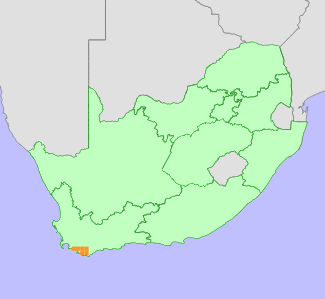|
Scientific Name | Aristea teretifolia Goldblatt & J.C.Manning |
Higher Classification | Monocotyledons |
Family | IRIDACEAE |
National Status |
Status and Criteria | Endangered B1ab(iii)+2ab(iii) |
Assessment Date | 2022/06/12 |
Assessor(s) | D. Raimondo, J.C. Manning & N.A. Helme |
Justification | An endemic to the Western Cape Province of South Africa, with a restricted range (extent of occurrence is 890 km²), that has lost more than 70% of its habitat. The remaining population is severely fragmented, and continues to decline due to ongoing habitat degradation and competition from alien invasive plants. It is therefore assessed as Endangered under criterion B. |
Distribution |
Endemism | South African endemic |
Provincial distribution | Western Cape |
Range | This species is endemic to a small area in the Overberg region of the Western Cape, where it occurs from Bot River to Bredasdorp and Elim. |
Habitat and Ecology |
Major system | Terrestrial |
Major habitats | Western Ruens Shale Renosterveld, Elim Ferricrete Fynbos, Central Ruens Shale Renosterveld |
Description | It occurs on slopes with ferricrete soils in renosterveld. |
Threats |
| More than 70% of this species' habitat has been lost to agriculture, and loss is continuing. Remaining subpopulations of Aristea teretifolia are threatened by competition from alien invasive plants in the Napier area, as well as overgrazing due to overstocking of small fragments of natural vegetation. |
Population |
Recent field observations recorded seven remaining subpopulations of Aristea teretifolia. All seven occur on isolated remnants, and three of these consist of fewer than 50 plants. Intact habitat remains at three other localities, where this species is known to occur through historical records. One of these, Shaw's Pass, has been frequently surveyed for threatened species in the past 15 years, and it was not recorded, and is therefore suspected to be locally extinct. As all known subpopulations are small and isolated, the population is considered severely fragmented. A continuing decline is inferred from ongoing habitat loss and degradation.
|
Population trend | Decreasing |
Assessment History |
Taxon assessed |
Status and Criteria |
Citation/Red List version | | Aristea teretifolia Goldblatt & J.C.Manning | EN B1ab(iii) | Raimondo et al. (2009) | |
Bibliography |
Goldblatt, P. and Manning, J.C. 1997. New species of Aristea (Iridaceae) from South Africa and notes on the taxonomy and pollination biology of section Pseudaristea. Novon 7(2):137-144.
Goldblatt, P. and Manning, J.C. 2000. Cape Plants: A conspectus of the Cape Flora of South Africa. Strelitzia 9. National Botanical Institute, Cape Town.
Goldblatt, P. and Manning, J.C. 2020. Iridaceae of southern Africa. Strelitzia 42. South African National Biodiversity Institute, Pretoria.
Raimondo, D., von Staden, L., Foden, W., Victor, J.E., Helme, N.A., Turner, R.C., Kamundi, D.A. and Manyama, P.A. 2009. Red List of South African Plants. Strelitzia 25. South African National Biodiversity Institute, Pretoria.
|
Citation |
| Raimondo, D., Manning, J.C. & Helme, N.A. 2022. Aristea teretifolia Goldblatt & J.C.Manning. National Assessment: Red List of South African Plants version . Accessed on 2025/08/23 |
 Comment on this assessment
Comment on this assessment


